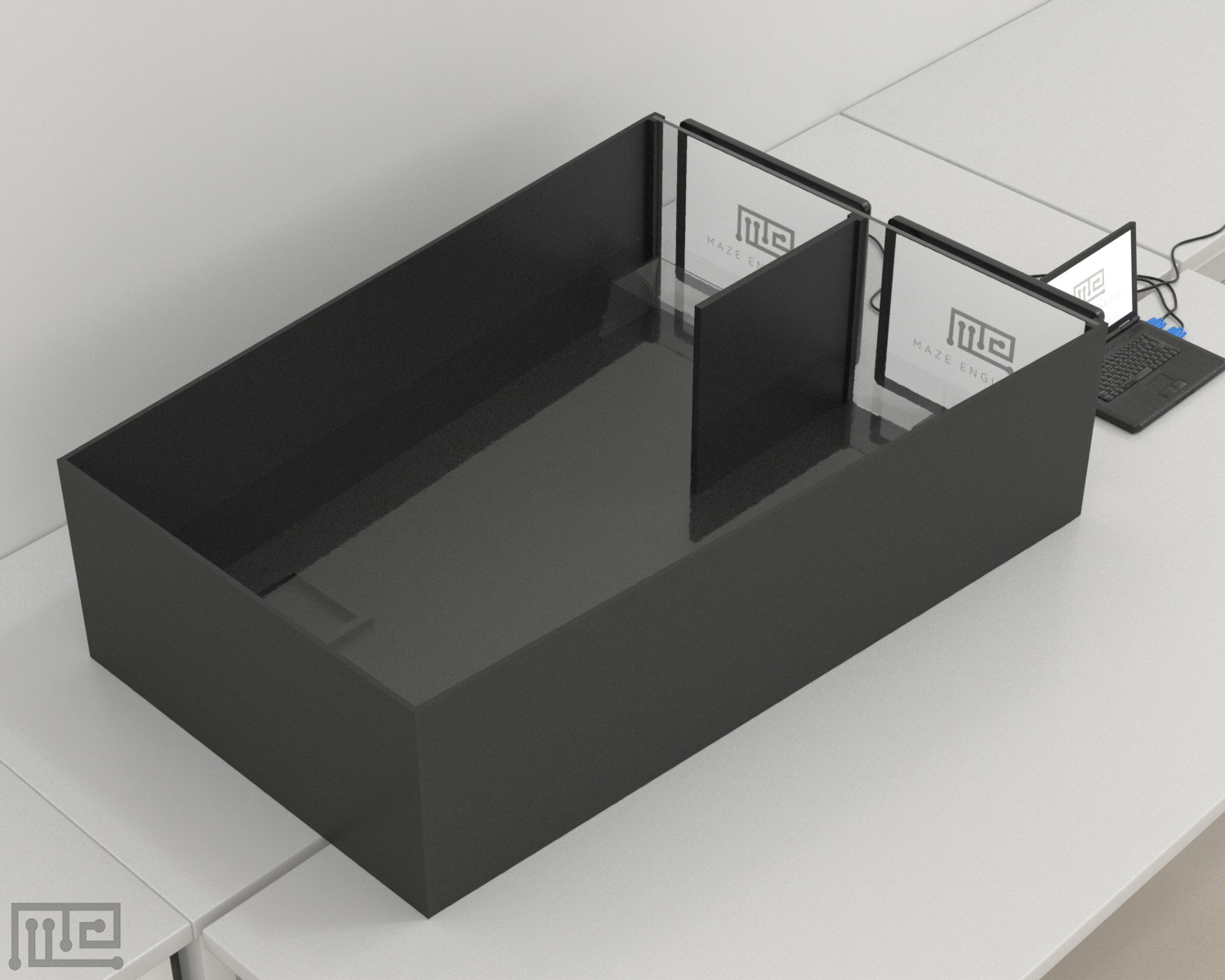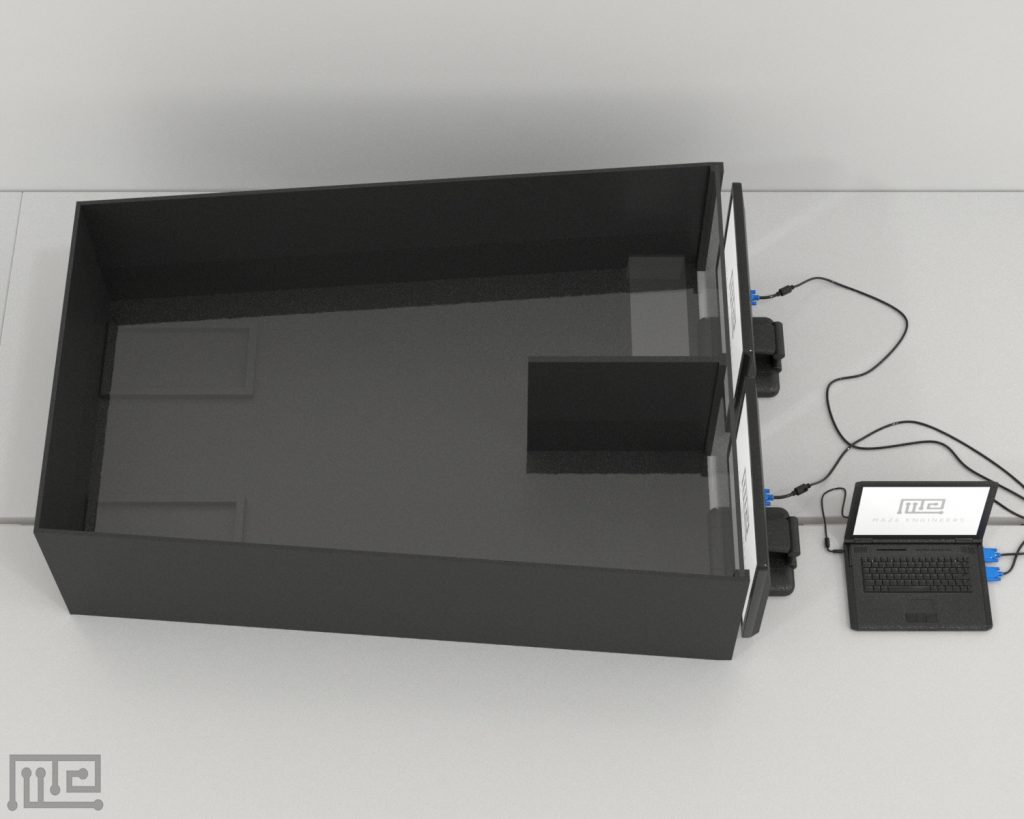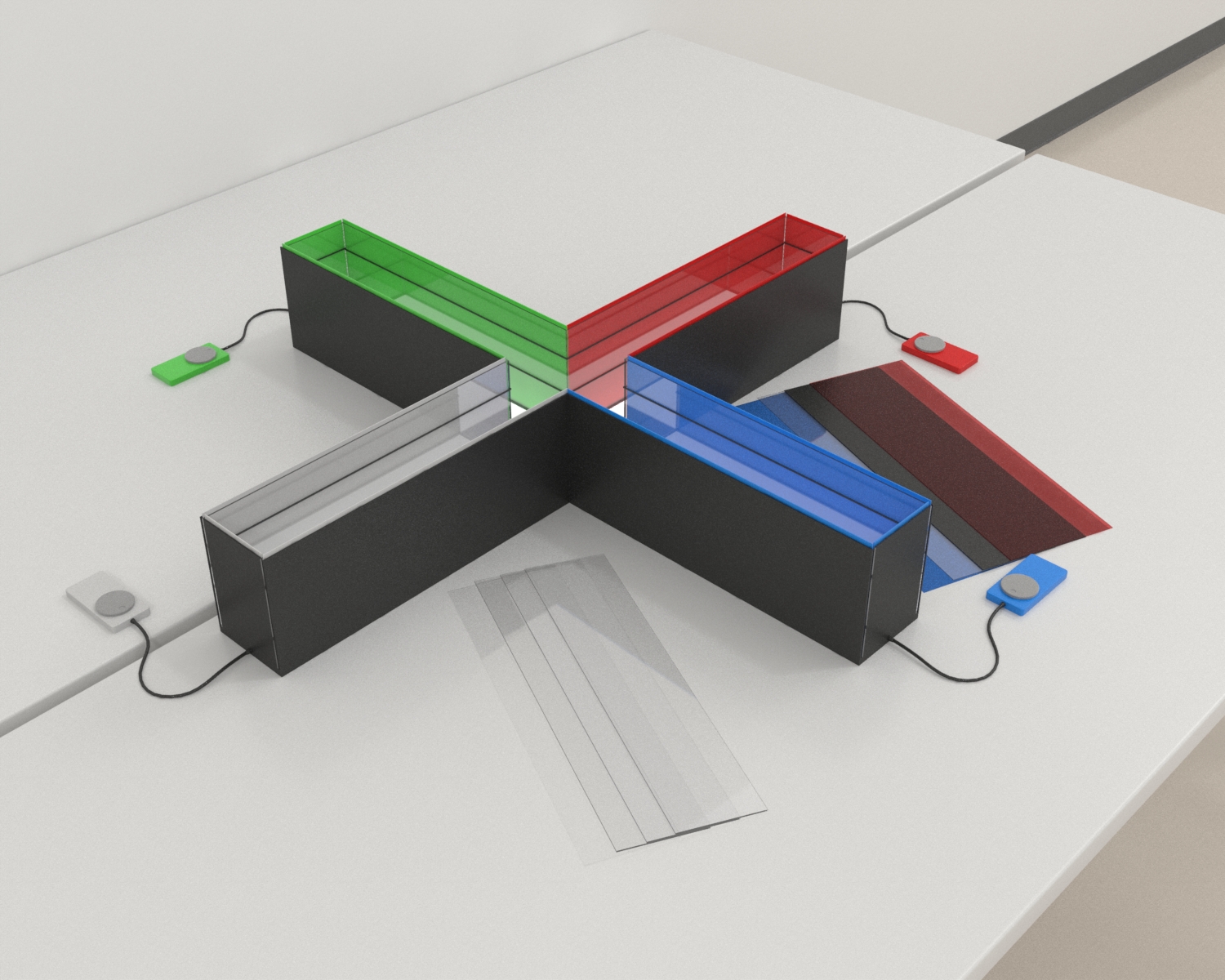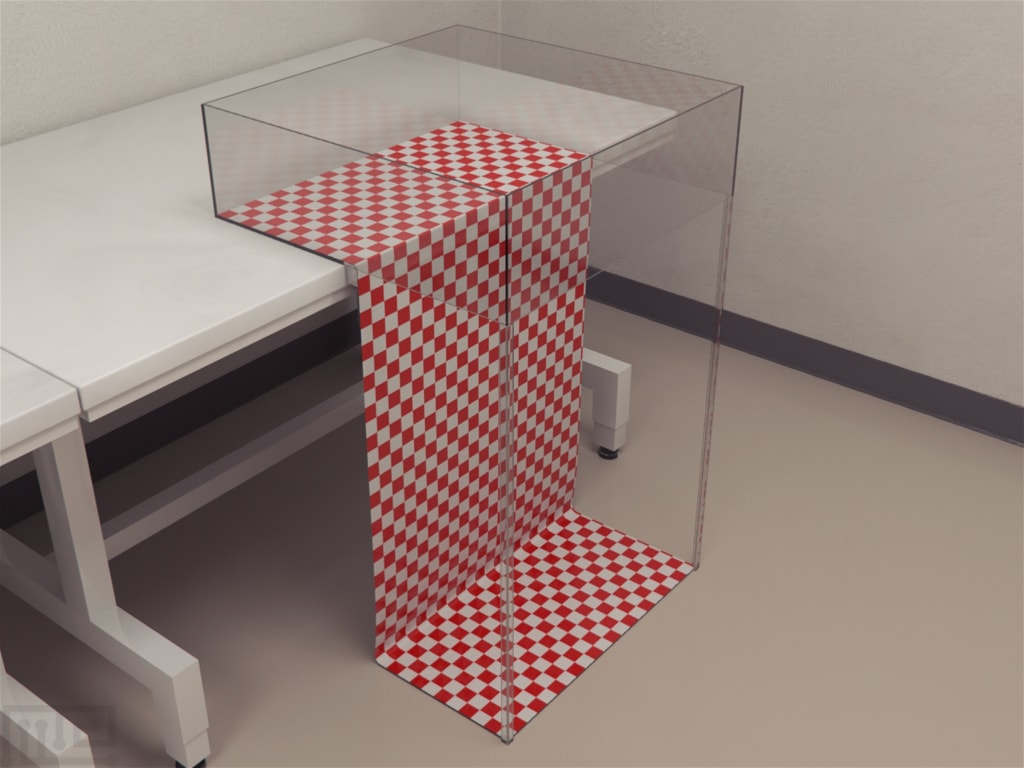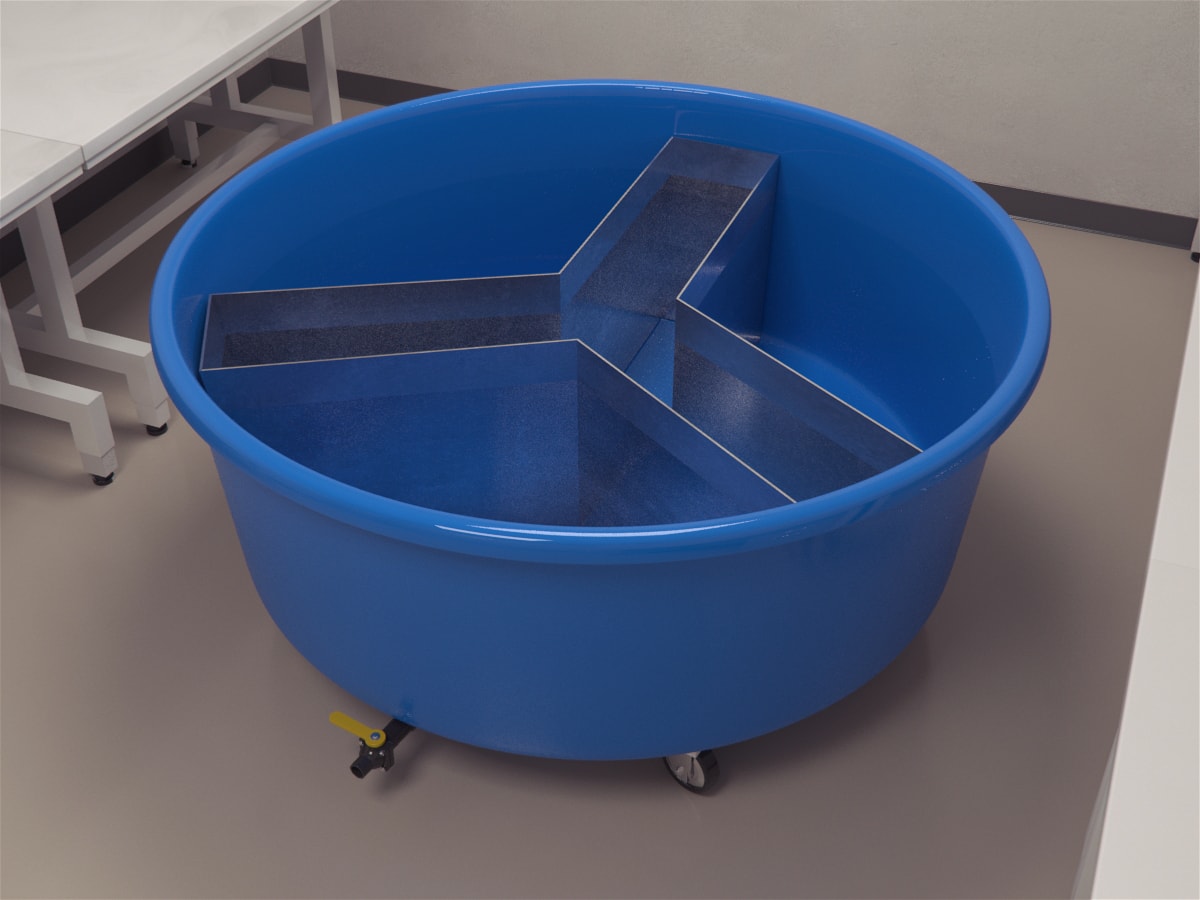The Visual Water Box is used to study learning and memory behaviors in rodents when presented with a visual stimulus. It can be used to evaluate different learning behaviors in rodents using different experimental protocols.
The visual water box is a trapezoidal-shaped pool. The narrow end of the pool is equipped with a release chute. The wider end of the pool is divided by a high opaque midline divider. Each half can be equipped with a computer-controlled monitor with software to display visual cue designs (customizable). The apparatus also comes with an escape platform that serves as the hidden platform.
Mazeengineers offer the Visual Water Box.
Price & Dimensions
Mouse without monitors
$ 2690
+S&H- Length of pool: 93cm
- Depth of pool: 26.6cm
- Length of release chute: 23cm
- Width of release chute: 5cm
- Height of release chute: 13cm
- Length of divider: 27cm
- Height of divider: 26.6cm
- Length of escape platform: 25cm
- Width of escape platform: 9cm
- Height of escape platform: 9.3cm
Mouse with monitors
$ 4380
Per Month- Computer-controlled monitors x2: 28.6cm
- + mouse dimensions
Rat without monitors
$ 2990
+S&H- Length of pool: 140cm
- Depth of pool: 40cm
- Length of release chute: 35cm
- Width of release chute: 7 m
- Height of release chute: 20cm
- Length of divider: 41cm
- Height of divider: 40cm
- Length of escape platform: 37cm
- Width of escape platform: 13cm
- Height of escape platform: 14cm
Rat with monitor
$ 4980
Per Month- Computer-controlled monitors x2: 28.6cm
- + rat dimensions
Documentation
Introduction
The visual water box is used to study learning and memory behaviors in rodents when presented with a visual stimulus. It consists of a trapezoidal-shaped pool that is partially divided on one end creating two arms. At the end of each arm, a computer monitor is placed which displays visual stimuli.
The visual system has been widely used as a model to study different brain functions. Behavioral tasks allow understanding of the interaction of the visual system with other brain systems and can quantitively measure visual ability (Wong & Brown, 2007). The visual water box relies on the visual system of rodents and also exploits their natural inclination to escape from water by providing a hidden platform. The animals are tasked with associating the visual cue with the correct arm in order to reach the platform.
The visual water box can be used to evaluate different learning behaviors in rodents using different experimental protocols. Furthermore, the visual water box can also be used to evaluate the effects of diseases and disorders, brain lesions, and pharmacological manipulations on learning and memory. Other similar apparatuses used in the evaluation of learning and memory in rodents include the Visual cliff test and the Morris water Y-maze.
Similar Products
Apparatus and Equipment
The Visual Water Box is a trapezoidal-shaped pool with the narrow end of the pool equipped with a release chute measuring and the wider end of the pool divided by an opaque midline divider. The apparatus also comes with an escape platform that serves as the hidden platform.
Two monitors can be included to be placed at the bottom of each divided end of the pool. Visual cues and stimuli can be projected on each monitor and can be configured using our Conductor software,
Examples of visual cues and stimuli used with the Visual Water Box include variable contrasts, differing colors, differing moving images (Lin et al., 2008).

Take advantage of Neuralynx, Ethovision Integration, SMS and Email integration with the Conductor Science Software. No I/O Boxes Required
Training Protocol
Apply appropriate overhead lighting to the apparatus. A tracking and recording system such as the Noldus Ethovision XT can be used to assist with observations.
Fill the pool to a depth of 15 cm with room temperature water (22 °C).
Habituation and Pre-training
Display a low spatial frequency grating on one of the screens. Position the platform directly below the grating. Release the subject into the pool a few centimeters from the platform. Allow the subject to remain on the platform for a few seconds once it reaches it. Remove the subject from the platform. Switch the location of the grating and the platform to the opposite side and conduct another trial. Repeat the sequence a few times and gradually increase the release distance from the platform until the subject can reliably swim to the platform from the opposite end of the pool.
Visual water box training task
Display a low-frequency sine-wave grating of ~ 0.12 cycles/degree on one screen and a homogeneous gray on the other screen. Place the platform under the screen that displays the grating. Let the subject enter the visual water box through the release chute and locate the platform. Remove the subject from the box when it climbs onto the hidden platform or enters the arm with the gray screen. Randomly alternate grating and platform position in succeeding trials. Conduct trials until animals have achieved 80% of correct choices over 20-40 trials.
Visual water box visual acuity testing task
Display a low-frequency sine-wave grating on one screen and a homogeneous gray on the other computer screen. Place the subject in the release chute and allow it to find the platform under the grating. If a correct choice is made, increase the spatial frequency of the stimulus by adding one cycle to the stimuli on the screen. Continue this procedure until an error is made. Once an error occurs, run additional trials until four correct responses are made in sequence, or seven correct choices are made in a block of ten trials. After trials covering approximately half of the animal’s projected threshold are completed, increase the minimum number of trials to three, and then again increase it to four around three-quarters of the projected threshold. Test mice in groups of five to six in a session of ten interleaved trials. Conduct each session for 45-60 min. Perform a maximum of three sessions per day for mice and up to 15 sessions for rats. A final threshold estimate is generated in 2 or 3 days with about 60 trials for mice, and 150 for rats.
Evaluation of visual acuity in mice and rats
Prusky, West, and Douglas (2000) conducted a behavioral assessment of visual acuity in mice and rats on a Visual water box. For the training phase, the mice and rats were required to distinguish the low spatial frequency sine-wave grating (~0.12 cpd) from a homogenous gray screen. Accuracy of task performance was maintained at 70% of correct choices. Both animals performed at or near chance during the first trial block. However, after two to three more blocks of training, a near-perfect performance was achieved, indicating that both animals eventually learned the task. The testing phase included small incremental changes in the spatial frequency of the stimulus between successive blocks of trials until the ability of animals to distinguish a grating from gray fell to chance. It was observed that there was consistency in the acuity of animals within a species. The average acuity of mice was 0.49 cycles/degree, while the average acuity of rats was 0.94 cycles/degree.
Evaluation of age-related changes in visual acuity, learning, and memory in mice
Wong and Brown (2006) tested age-related changes in visual acuity, learning, and memory in DBA/2J and C57BL/6J and congenic B6. mpc1d and D2. mpc1b strains of mice. In addition to the Visual water box, mice were also tested on a Morris water maze and olfactory discrimination learning task. The Mice were of 6, 12, 18, and 24 months of age. When the mice were tested on the visual water box, it was observed that performance was dependent upon the age and strain of the subjects in visual detection, pattern discrimination and visual acuity in the four strains of mice. It was found that C57BL/6J and B6. mpc1d strains performance improved with age, while DBA/2J and D2. mpc1b strains performance got worse with age, in spite of both strains having the same practice. Age-related strain difference was also seen in the Morris water maze. Although at 6 months of age, there was no strain difference seen in the performance of the task, the difference in task performance was seen in 12, 18, and 24 months of age. The DBA/2J and D2. mpc1b mice had longer latencies and swam a greater distance to find the platform than the C57BL/6J and B6. mpc1d mice. Strains did not differ in performance in the olfactory learning task. The results indicated that a decrease in performance in some strains was a result of age-related vision loss or disorders which represents a link in age-related changes in the neurophysiology of the visual system and the deficits in visually guided behavior.
Evaluation of the effects of environmental enrichment on the visual abilities and ocular dominance of mice
Greifzu, Kalogeraki, and Löwel (2015) investigated the effect of environmental enrichment in C57BL/6J mice in a visual water box task. Subjects were either raised in an enriched environment (EE) or in standard cages (SC). For measurement of visual acuity, the mice had to distinguish a low spatial frequency grating of 0.086 cycles/degree from an equiluminant gray screen. For measurement of orientation discrimination, the mice were trained to distinguish between horizontal and vertical square wave gratings of 0.086 cycles/degree. Results indicated that old SC- mice had a visual acuity of 0.51 ± 0.02 cycles/degree, whereas old EE-mice had a visual acuity of 0.48 ± 0.01 cycles/degree. It was observed that visual acuity, orientation discrimination, and learning the visual water box task were similar in both EE and SC mice. Apart from the visual water box mice were also tested on the virtual-reality optomotor setup. It was observed that there were similar spatial frequency and contrast thresholds of the optomotor reflex in both EE- and SC-mice. After completion of all behavioral vision tests, visual cortical responses were recorded and analyzed. It was observed that environmental enrichment extended as well as restored ocular dominance plasticity into old age. Overall, visual acuity and other visual parameters were not higher in EE compared with SC-mice, however, raising mice in an enriched environment in contrast to standard cages increased brain plasticity and extensively modified the molecular composition of the cortex.
Data Analysis
The following parameters can be observed on the visual water box:
- Frequency of finding the hidden platform
- Frequency of entry into an incorrect arm
- Time spent to find the platform
- Time spent on the platform
- Frequency of errors
Strengths and Limitations
Strengths
The visual water box is used to study learning and memory behaviors in rodents when presented with visual stimuli displayed on two computer-controlled monitors. The monitors allow easy manipulation of the visual stimuli without interrupting the task. The visual water box challenges the natural inclination of rodents to escape from water by providing a hidden escape platform. The non-invasive nature of the visual water box makes it a reliable task to measure the visual capabilities of rodents. Evaluation of visual capabilities can be done with great speed compared to other behavioral techniques such as the forced-choice Y maze and the jumping stand. The visual water box can be used to study plasticity of the brain and can also be used to test the effects of diseases and disorders, brain lesions, and pharmacological manipulations on learning and memory.
Limitations
Training the subjects is essential to using this apparatus and uses a substantial amount of time. Accurate testing cannot be achieved through excessive retraining or prolonged testing. Preference of a single maze arm by the subject may affect task performance. Presence of unnecessary stimuli may affect the way the subject performs the task. Task performance may be influenced by age and strain of the subject. Overtraining of the subject can result in muscle fatigue. Forced swimming may be an aversive stimulus for the subject and may affect task performance.
Summary
- The Visual Water Box is used to study learning and memory behaviors in rodents when presented with a visual stimulus.
- The Visual Water Box consists of a trapezoidal-shaped pool that is partially divided on one end creating two arms. At the end of each arm, a screen is placed, which displays visual stimuli.
- Visual capabilities of rodents can easily be measured using the Visual Water Box and can be done with great speed.
- The Visual Water Box can also be used to test the effects of diseases and disorders, brain lesions, and pharmacological manipulations on learning and memory.
References
- Greifzu F., Kalogeraki E., Löwel S. (2016). Environmental enrichment preserved lifelong ocular dominance plasticity, but did not improve visual abilities. Neurobiology of Aging (41), 130–137. doi: 10.1016/j.neurobiolaging.2016.02.014
- Prusky G.T., West P.W., and Douglas R.M. (2002). Behavioral assessment of visual acuity in mice and rats. Vision Research, 40(16), 2201–2209.
- Wong A.A., & Brown R.E. (2007). Age-related changes in visual acuity, learning and memory in C57BL/6J and DBA/2J mice. Neurobiology of Aging, 28(10), 1577-1593. doi: 10.1016/j.neurobiolaging.2006.07.023
- Lin B, Koizumi A, Tanaka N, Panda S, Masland RH. Restoration of visual function in retinal degeneration mice by ectopic expression of melanopsin. Proc Natl Acad Sci U S A. 2008 Oct 14;105(41):16009-14. doi: 10.1073/pnas.0806114105. Epub 2008 Oct 3. PMID: 18836071; PMCID: PMC2572922.
Request a quote
"*" indicates required fields

